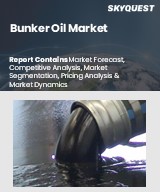
Report ID: SQMIG15A2510
Skyquest Technology's expert advisors have carried out comprehensive research on the bunker oil market to identify the major global and regional market trends and growth opportunities for leading players and new entrants in this market. The analysis is based on in-depth primary and secondary research to understand the major market drivers and restraints shaping the future development and growth of the industry.
Bunker Oil Market Drivers
International Trade Facilitate Market Growth
Regulations on Environmental Quality Fuel Market Growth
Bunker Oil Market Restraints
High Prices for Alternative and Low-Sulfur Fuels
Supply Chain Disruptions and Geopolitical Uncertainty
REQUEST FOR SAMPLE
Global Bunker Oil market size was valued at USD 430 Million in 2023 and is poised to grow from USD 447.63 Million in 2024 to USD 620 Million by 2032, growing at a CAGR of 4.1% in the forecast period (2025-2032).
Major players operating within the global competitive bunker oil market include BP, Chevron, Exxon Mobil, and HPCL, who are constantly striving to stay ahead of the competition. Moreover, to sustain their competitive advantage, market leaders cooperate with other firms. Investment in product launches is continuing to extend the product portfolio. Mergers and acquisitions are among the chief strategies key players employ in expanding their product portfolios. 'Bunker Holding', 'World Fuel Services Corporation', 'TotalEnergies Marine Fuels', 'BP Marine', 'Shell Marine', 'Chevron Marine Products', 'ExxonMobil Marine Fuels', 'PetroChina International', 'GAC Bunker Fuels', 'Monjasa', 'Titan LNG', 'Minerva Bunkering', 'Dan-Bunkering', 'Fujairah Refueling Centre', 'Vitol Bunkers'
The demand for bunker oil has a direct correlation with international trade activity. As international trade grows in demand, the demand for ships and marine fuel rises tremendously. Global trade is mainly impacted by factors such as economic expansion, changing consumer tastes, and political events. In addition, further market integration of emerging economies into global trade patterns is expected to augment bunker fuel consumption and the growth of the global bunker fuel market.
Increasing Use of Biofuels and LNG: Shipping companies are rapidly switching to the use of liquefied natural gas, biofuels, and synthetic fuels for their operations instead of conventional bunker oil because of the requirements for stricter emissions. The development of an LNG bunkering facility is a clear indication of the promising future of renewable biofuels as alternative energy for the environment. Carbon footprints reduced sulfur emission support to all global sustainability objectives and would also go along with cleaner shipping operations.
North America holds a significant portion of the bunker oil market owing to its well-developed maritime industry and well-link ports in the global market network. The region's requirement for bunker oil varies directly with increasing international trade because emerging economies increase the demand for naval fuel. Growth in LNG bunkering, and other communes was critical and impacted by the dynamics of the utilization of low-sulfur fuels. Government initiatives such as North American Emission Control Areas (ECAs) also promote the consumption of cleaner fuels. Market patterns are greatly driven by, but not limited to, current geopolitical events, consumer demands, and economic growth.
Want to customize this report? This report can be personalized according to your needs. Our analysts and industry experts will work directly with you to understand your requirements and provide you with customized data in a short amount of time. We offer $1000 worth of FREE customization at the time of purchase.
Feedback From Our Clients

Report ID: SQMIG15A2510
sales@skyquestt.com
USA +1 351-333-4748